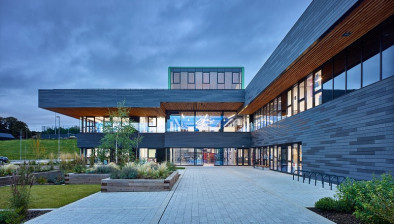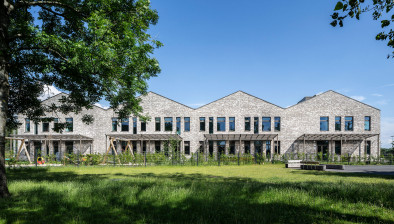Green light for transformation of St James church hall site in Portobello

A two-year development programme set to revitalise the St James Church site in Portobello is set to start early next year after phase one of the Edinburgh project was given the go-ahead.
The work will see three family townhouses replace the 1970s’ church hall and car parking area behind the Grade-B listed church on Rosefield Place.
The site was acquired in 2015 after the Church of Scotland made the decision to sell two out of their three local churches and associated halls when falling congregations made operating and maintaining them unviable. The Church Congregation Committee chose a bid that promised a small-scale development sympathetic to the existing style and character of the neighbouring houses.
The developer, Pete Turner, has partnered local architect Sonia Browse on previous small scale developments in conservation areas and sees sensitive yet distinctive design as a cornerstone of his projects.
He said: “From the start we intended this to be a development that enhanced and preserved the style of the area, while being sympathetic to the existing listed church building. The positive feedback we received from consultation with Edinburgh Council, the church committee and residents’ associations throughout the pre-planning phase affirmed our purpose and design objectives, and furthered our confidence that we would achieve planning permission for the site.”
The design of the mews houses is inspired by the ‘linked villa’ style typical of the Brighton and Rosefield area. The garage of each property is set back from the street, joining houses together in a similar way to the single-story wings which link the late-Georgian properties in the neighbouring streets. Elements of the design borrow from the Gothic ‘perpendicular style’ of the church itself.

Despite being a modest two-storey size, the houses have a vertical emphasis created by separating and modelling the two planes of the front elevation, which draws the eye up to the sky, echoing the soaring arches and gable profiles of the Church. This is further emphasised by the tall windows which appear to be double-height, starting on the ground floor and continuing from above a first-floor planter to the upper floor of the house.
These large, high-spec family townhouses are likely to prove popular with a growing Portobello population. Each feature light-filled open-plan living spaces with under-floor heating and wood-burning stoves on the ground floor opening through large bi-fold doors to south-east facing private gardens at the rear. Central stairs lead to four generously sized double bedrooms, each with exposed trusses two of which have large clearstory glazing whilst the other two leading on to an upper terrace. A large window from the terrace draws light down the stair in the centre of the plan.
The outside space responds to Scottish Government recommendations on making ‘Streets as places first’. Designed as a quiet mews with no access to through traffic, the common area in front of the houses will be opened up to provide a social, community space and place for children to play.
The sustainable house designs have been arranged to maximise daylight and passive heat gains which the design of the triple aspect homes allows cross ventilation and good levels of natural ventilation through the home. The homes with be built with a timber kit and fabric first approach with good airtightness levels complemented by a mechanical heat recovery ventilation system (MHRV).
Sonia Browse, partner at Sonia Browse Architects LLP, said: “Our hope is that the new mews will add to, and become a part of, Portobello’s rich and varied identity. We are delighted that the council are happy with the designs and have granted planning permission.”
The second phase, focusing on the conversion and preservation of the Church itself, is already under way, with consultation on the plans expected in Spring/Summer 2017.
It is envisaged that the townhouses will be completed in autumn 2017 and formally marketed in spring 2017.














